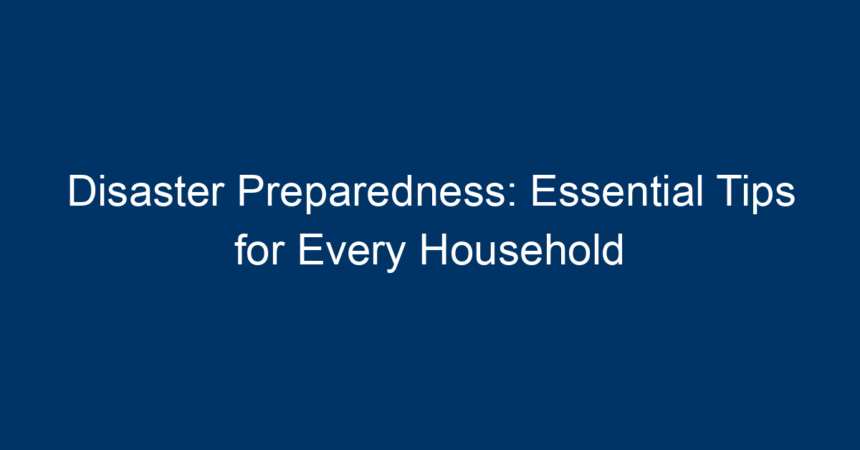In an unpredictable world, being prepared for disasters is not just an option; it’s a necessity. From natural calamities like hurricanes and earthquakes to human-made emergencies such as terrorist attacks and pandemics, the unfortunate reality is that disasters can strike at any time. This is where disaster preparedness comes into play. By taking proactive steps, households can ensure safety, mitigate damages, and recover more swiftly when the unexpected occurs. This guide will walk you through essential tips for disaster preparedness that every household should implement.
Understanding Disaster Preparedness
What is Disaster Preparedness?
Disaster preparedness involves planning and preparing for potential emergencies to minimize their impact on your life and your home. It includes forming a plan, creating a disaster supply kit, and ensuring all family members are educated about what to do in case of an emergency.
Why Disaster Preparedness is Crucial
The benefits of disaster preparedness extend beyond just survival; they include:
- Protection: Being prepared can safeguard your loved ones and belongings.
- Peace of Mind: Knowing you have a plan can significantly reduce anxiety.
- Faster Recovery: Prepared households often bounce back quicker than those without plans.
- Community Resilience: Prepared individuals contribute to a more resilient community.
Common Types of Disasters
Understanding the types of disasters that may affect your area is vital in shaping an effective disaster preparedness plan. Common disasters include:
- Natural Disasters: Earthquakes, floods, hurricanes, tornadoes, and wildfires.
- Technological Disasters: Chemical spills, power outages, and infrastructure failures.
- Human-Made Emergencies: Acts of terrorism, civil unrest, or pandemics.
Creating a Family Disaster Plan
An effective disaster plan is the cornerstone of disaster preparedness. Here’s how to create one:
Step 1: Assess Risks
Start by evaluating the types of disasters that are most likely to occur in your area. This could involve checking local history and considering environmental factors.
Step 2: Designate Meeting Points
Choose both a local meeting spot and an out-of-town destination where family members can gather in case you get separated. Make sure everyone knows the locations.
Step 3: Communication Plan
Establish a communication strategy. Determine how family members will contact each other during an emergency and ensure everyone has a list of important phone numbers.
Step 4: Assign Roles
Assign specific roles to each family member. Whether it’s gathering supplies, managing the pet, or contacting neighbors, everyone should know their responsibilities.
Step 5: Regularly Review and Practice Your Plan
Schedule regular reviews of your plan and conduct drills to ensure everyone is familiar with what to do.
Building a Disaster Supply Kit
A well-stocked disaster supply kit is a key component of disaster preparedness. Here’s what you should include:
Basic Supplies
- Water: At least one gallon per person per day for three days.
- Non-perishable Food: Stock enough food for at least three days. Consider items like canned goods, granola bars, and dried fruits.
- First Aid Kit: Include bandages, antiseptics, burn cream, and any medications your family needs.
Essential Tools and Equipment
- Flashlight: Don’t forget extra batteries.
- Multi-tool: Handy for a variety of tasks.
- Battery-Powered or Hand-Crank Radio: Stay informed about weather updates and emergency instructions.
Personal Items
- Important Documents: Copies of IDs, insurance policies, and medical records stored in a waterproof container.
- Clothing: Extra clothes, sturdy shoes, and warm blankets.
- Cash: In the event of power outages, ATMs may be inoperative.
Educating Your Family
Knowledge is power when it comes to disaster preparedness. Ensure all family members understand the plan and their roles:
Conduct Training Sessions
Regular family meetings can be effective for discussing disaster preparedness. Include:
- First Aid Training: Enrolling in a first aid and CPR course can be incredibly beneficial.
- Fire Safety: Teach family members how to use a fire extinguisher and review evacuation routes.
Involve Everyone
From the youngest to the oldest, everyone should be involved. Older children can take on more responsibilities, while younger kids can learn how to alert an adult in an emergency.
Community Involvement
Don’t underestimate the power of community in disaster preparedness. Engaging with neighbors can enhance your household’s readiness:
Form a Neighborhood Network
Coordinate with your neighbors to share resources and information. This could involve:
- Shared Resources: Pool supplies and skills, such as medical knowledge or heavy equipment.
- Community Drills: Organize joint safety drills to practice how to react to various emergencies.
Know Local Emergency Services
Familiarize yourself with local emergency services and resources. This includes:
- Hospital Locations: Identify which hospitals and emergency rooms are nearby.
- Local Shelters: Know where nearby emergency shelters are located in case of evacuation.
Maintaining Your Preparedness
Preparedness is an ongoing process. Regularly update your supplies and training to keep your family ready:
Check Your Kits
- Expiration Dates: Regularly check and rotate food and medication supplies.
- Refill First Aid Kits: Ensure you replace any used items in your first aid kit.
Review Your Plan Annually
An annual review of your disaster preparedness plan ensures that everyone remains well-informed and that any necessary updates or changes are made.
Conclusion: Taking Action on Disaster Preparedness
In summary, disaster preparedness is essential for every household. By creating a comprehensive family plan, building a robust disaster supply kit, educating your family, and contributing to your community’s preparedness, you can significantly enhance your safety and resilience in the face of emergencies.
Remember, the goal is not just to survive a disaster, but to thrive in its aftermath. Taking these steps today can make all the difference tomorrow. Implementing these disaster preparedness tips ensures that you and your loved ones are ready for whatever challenges may come your way.
It’s time to take action—review your current situation, and start your journey towards effective disaster preparedness today!




